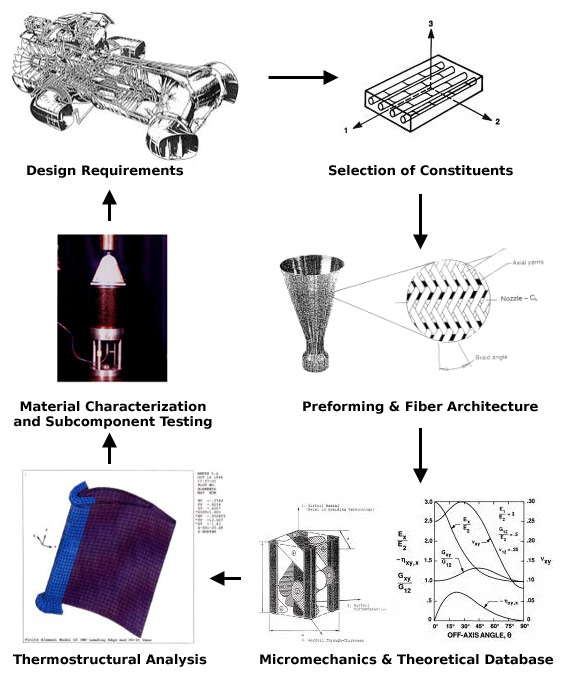- Expertise
- Our Work
- SBIR / STTR
- Request A Quote
- Contact
Ceramic Matrix Composites
MR&D specializes in the design of ceramic matrix composites for extreme environment applications. The principals within the firm have been engaged in the design of carbon-carbon and ceramic matrix composites since the early 1980s.
The process begins with the specification of design requirements by the end-item user. These design requirements typically take the form of design loads (static, dynamic, thermal, lifetime requirements, etc.), the geometric envelope of the component, and other goals (e.g., maximum weight, maximum cost) of interest to the user.
Based on these design requirements, the constituents of the design can be selected. For example, for a highly oxidative environment at moderate temperatures, ceramic fibers may be appropriate. Very high temperatures, high strength requirements and/or tight cost constraints may push the design towards the use of carbon fibers.
The next step in the design process is the consideration of the most appropriate preform. A cylindrical-shaped item may benefit from a braided architecture. Flat or slightly curved components may be well suited for fabric reinforced preforms. Woven preforms with through thickness reinforcement may be appropriate for parts requiring interlaminar properties beyond those associated with two-directionally reinforced preforms. Non-woven preforms may be best for composites requiring significant interlaminar properties.
In order to have thermo-elastic moduli and/or thermal conductivity properties available for stress analysis and/or heat transfer analyses of the composite design, MR&D makes use of our in-house proprietary micromechanics codes for the calculation of temperature-dependent anisotropic properties. MR&D is in possession of a suite of such codes, which include codes for determining fiber orientations and fiber volume fractions for 2-D and 3-D braided preform composites, 2-D fabric reinforced composites, and 3-D woven preform reinforced composites. Using information generated by these codes, together with fiber and matrix properties baselined from composite data accumulated at MR&D over several decades, MR&D computes all of the temperature-dependent anisotropic thermal conductivity and thermo-elastic properties required for the analyses of our designs. Our in-house data base also includes measured data on composite strengths, from which temperature-dependent strengths are also generated.
At MR&D, thermal and thermostructural analyses are primarily performed using commercially available finite element codes, including ANSYS and ABAQUS. Thermal analyses produce temperature distributions, which are used to calculate thermal stresses in thermostructural analyses. Appropriate methods are used, based on physically reasonable load combination rules, to combine thermal stresses with stresses from static and/or dynamic analyses. Stress and strain results from the combined loads analyses are then used in calculating stress or strain margins of safety by which judgments on the suitability of our designs are based.
Composite Design Procedure
